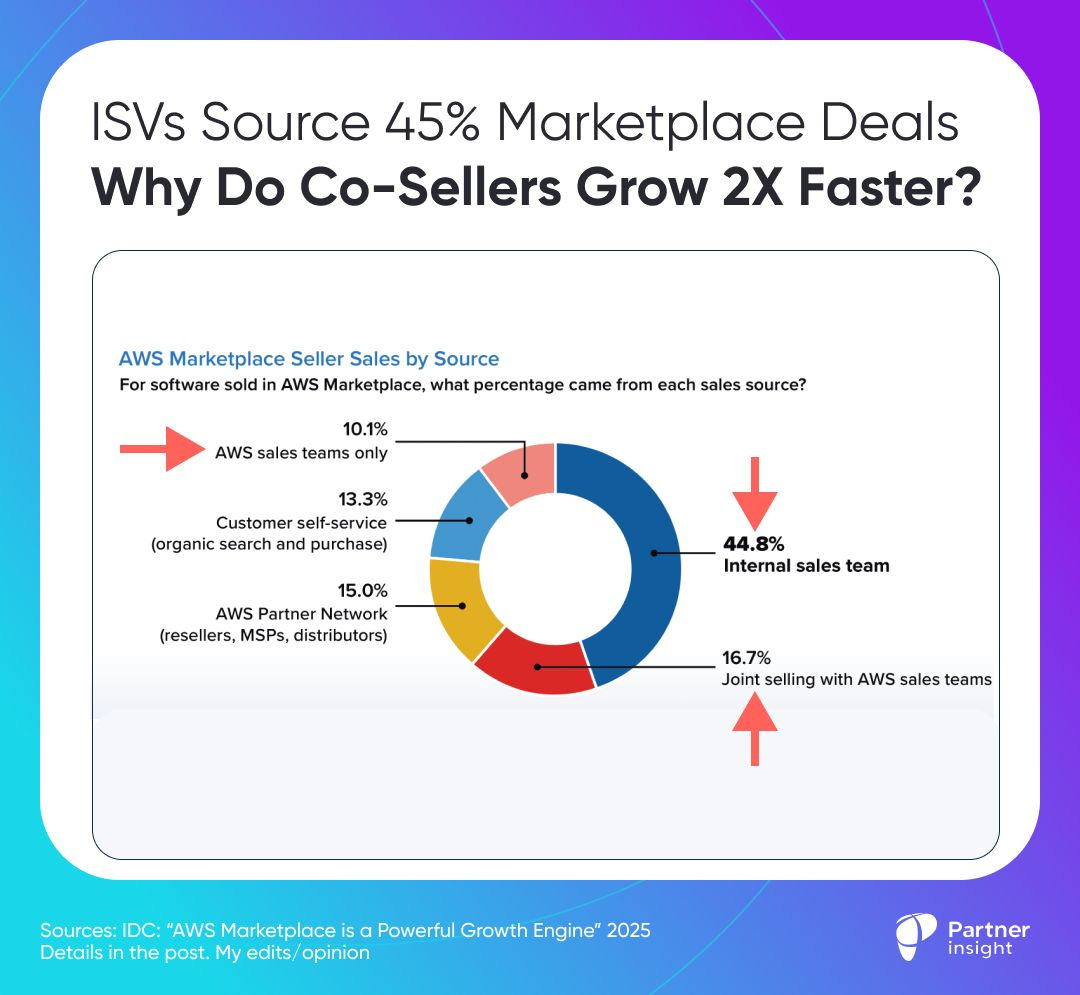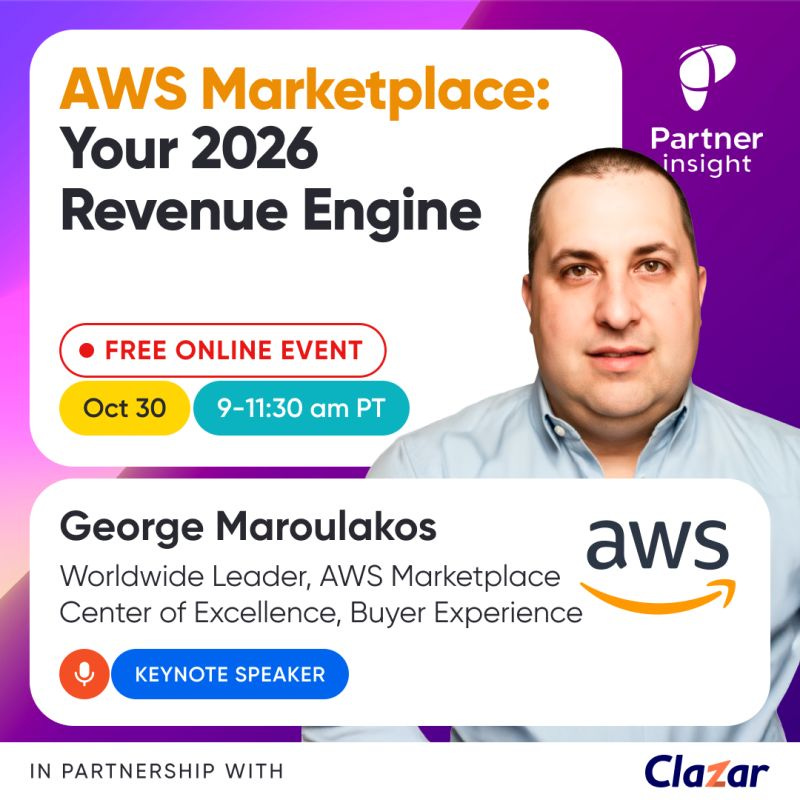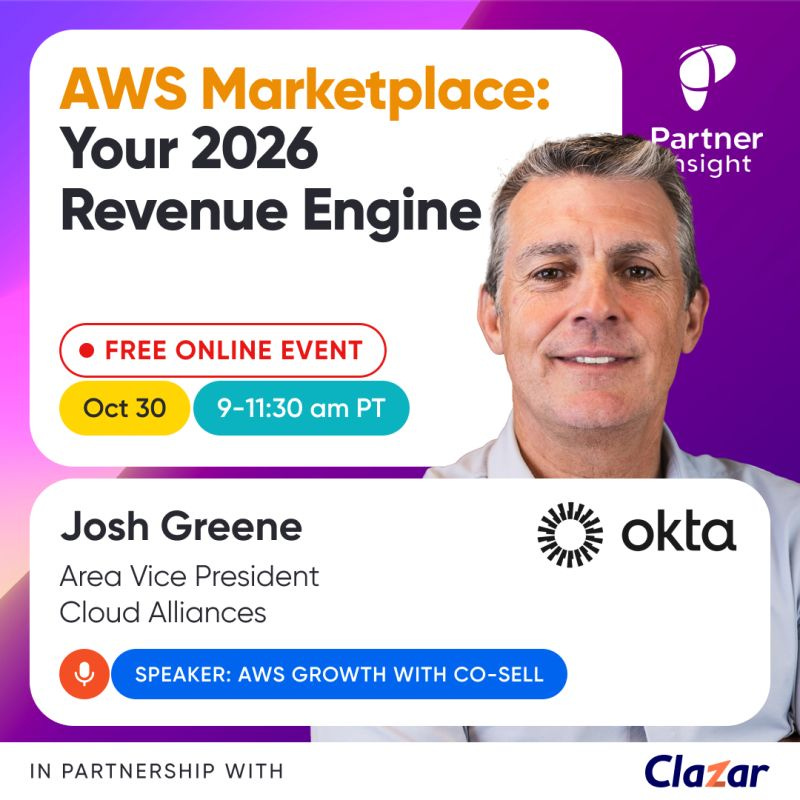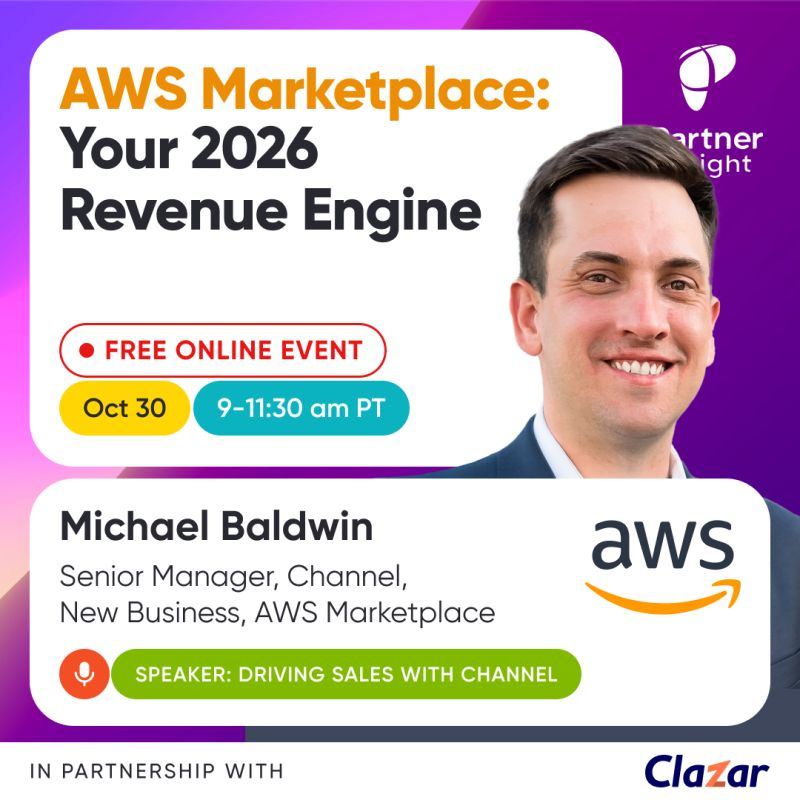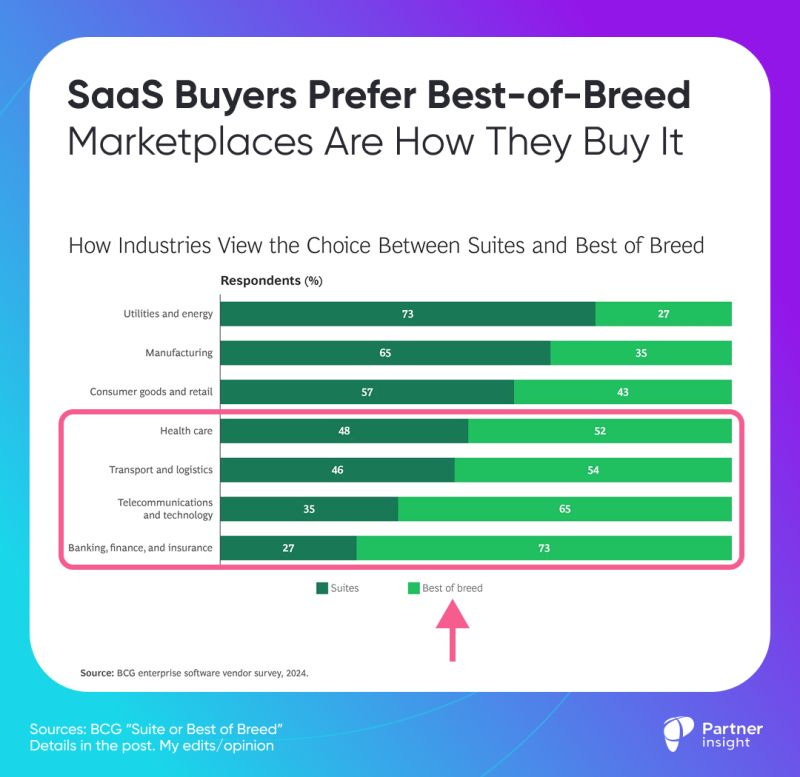ISVs Source 45% of Marketplace Deals—Why Co-Sellers Grow 2X Faster?
Hi, it’s Roman Kirsanov from Partner Insight newsletter, where I deconstruct winning Cloud GTM strategies and the latest trends in cloud marketplaces.
This week:
ISVs source 45% of Marketplace deals—yet co-sellers drive 2X faster growth. We’ll break down new IDC data on who’s actually sourcing marketplace business and explain how to use co-sell as the force multiplier.
Best-of-breed SaaS is winning where stakes are highest: 75% of banking/FS and 65% of tech buyers prefer BoB software over suites (BCG)—marketplaces are how customers adopt BoB fast and standardize commercially.
Inside AWS Marketplace buyer behavior & $1B+ co-sell strategies: Meet three leaders joining our Oct 30 event—George Maroulakos (WW Leader, AWS Marketplace CoE - Buyer Experience), Josh Greene (leads Global Strategic Cloud Alliances at Okta), and Michael Baldwin (scaled AWS Marketplace channel from 20 to several thousand partners)
10 days left: Join our biggest event “AWS Marketplace: Your 2026 Revenue Engine” —Jay McBain, AWS leaders, and execs from Anthropic, Pinecone, LucidLink, and others reveal their exact co-sell, channel, and marketplace growth strategies.
ISVs Source 45% of Marketplace Deals — Why Do Co-Sellers Grow 2X Faster?
Who actually sources Cloud Marketplace deals? And if hyperscalers “only” source 10–20% of deals, are Marketplace and co-sell overrated?
IDC’s recent AWS Marketplace study breaks down the numbers:
ISV AEs open most opportunities: 44.8% sourced by ISVs
Joint discovery (co-sell) with AWS: 16.7%
AWS-only sourced: 10.1%
The rest: APN partners 15.0%, self-serve/PLG 13.3%
At first glance, it looks like ISVs “do all the work” on marketplaces, while hyperscalers get the credit.
Here’s my read of the report—and why that interpretation misses what’s actually driving the 2X growth numbers.
The misconception killing marketplace strategies:
Many alliance leaders list in marketplaces expecting hyperscalers to source opportunities. When they get only handful of deals, it feels like a failed promise. But origination and co-sell are fundamentally different jobs, and confusing them leaves the biggest growth lever unused.
Reality: co-sell + Marketplace are force multipliers after origination.
Most ISV-sourced opps become co-sell later to accelerate the cycle, retire commits, and speed procurement/legal via Private Offers.
Why Co-Sell and Marketplace drive faster growth (report data)
Sellers who co-sell report 2X software sales growth vs. those who don’t.
75% of surveyed sellers co-sell with AWS and see that lift. If you’re not co-selling, you’re leaving the biggest lever unused.
Marketplace business accelerate 41% faster
AWS Marketplace revenue grows ~41% faster than the rest of software for surveyed sellers.
Private Offers are the enterprise default (>50% of Marketplace transactions)
More than half of AWS MP transactions are Private Offers; over a third of sellers’ reps have executed at least one
Marketplace KPIs are superior
Sellers cite shorter cycles (45%), faster cash collection (43%), more reliable payouts (48%), and stronger renewals (33%) vs. traditional motions.
Result? 23% of revenue through Marketplace
Companies listed 55% of their portfolios and with nearly a quarter of revenue via Marketplace, it’s now a core driver.
So what? Sourcing and co-sell are different jobs
Sourcing = open the door. Your AEs still generate most pipeline—by design.
Co-sell = finish the job. Pull AWS in to add account intel, credibility, learn about customer commits, get exec cover, and transact with a PO. That’s where the 2X shows up.
Yes, only ~10% of deals are sourced by hyperscalers and ~17% are jointly sourced.
Yet co-sell and Marketplace remain the growth engine because they change the outcome of the other 70% you sourced yourself.
Generate the pipeline; use AWS and MP to accelerate, de-risk, and close. That’s how companies already drive 23% of their revenue and growing.
Source: Research
How AWS Buyers Actually Purchase (+ Insights from the $1B Marketplace Club)
99% of the top 1,000 AWS customers had at least one active Marketplace subscription in 2024. For ISVs and partners, understanding this buyer shift—and how they navigate Marketplace—determines who wins.
On October 30, we’re bringing together the people who see this behavior most clearly—from AWS leaders tracking 3M+ active subscriptions to alliance leaders driving growth at $1B+ MP ISV and leading AI companies.
Last week we announced our keynote from Jay McBain, who just updated his marketplace forecast to $163B by 2030—nearly 2X his earlier predictions. This week, meet three more speakers whose insights will help you scale revenue on AWS Marketplace.
Inside the Buyer’s Journey
Most of us focus on what we’re selling. George Maroulakos focuses on how customers are buying—and few people see buyer behavior, frictions, revenue growth, and change signals as closely as he does.
As Worldwide Leader, AWS Marketplace Center of Excellence — Buyer Experience, George’s team tracks data from 3M+ active subscriptions—how customers discover, evaluate, buy and renew.
Marketplace opportunity keeps growing
99% of top 1,000 AWS customers had at least one active Marketplace subscription in 2024
Buyers achieve 70% faster product discovery, 60% time savings in procurement, and 30% faster time-to-market (Forrester)
50%+ of products now use Standard Contract, reducing legal friction
What this means for your 2026 GTM
The AI wave is compressing evaluation cycles and pushing buyers toward outcome-based, unified-billing motions. AWS Marketplace becomes the natural front door. For ISVs and partners, this is where packaging, pricing, co-sell strategy, and renewal motions need to converge.
George will show how buyers navigate this—join us to align your strategy with how buyers actually buy.
Co-Sell at $1B+ Marketplace Scale
Josh Greene leads Global Strategic Cloud Alliances at Okta after 5+ years at AWS building the Marketplace business with ISVs.
Josh’s perspective is rare, because he’s lived both sides of Marketplace co-sell:
At AWS he built the Marketplace Development function and Seller Experience from IC to a global team
Now he leads Cloud GTM and a team that drives AWS co-sell engagement at Okta, one of the few companies that surpassed $1B in sales via AWS Marketplace (and 2024 Global AWS Marketplace Partner of the Year)
What’s more, 100% of Okta’s top 20 deals last quarter were partner-touched—evidence that the MP + partner model is essential for enterprise. Josh brings a practical view on how it works.
What he’ll share:
AWS expectations vs. ISV reality in co-sell—what’s working and how to keep deals moving
Better Together positioning that gains AWS traction
Using data in co-sell to maximize conversion and retention
Why AI products are marketplace-first, and what that means for your 2026 GTM
After helping grow Marketplace at AWS, Josh’s mandate at Okta is simple: build co-sell that turns into ARR. He’ll break down what works when tested at enterprise scale.
Channel-Marketplace Convergence
Channel-attached Marketplace deals are becoming the norm for enterprise. Want to understand why?
Michael Baldwin, Sr. Manager, Channel, New Business, AWS Marketplace will join our Ecosystem panel to break it down. Over the last six years, Mike helped scale the AWS Marketplace channel from 20 partners to thousands —a thriving ecosystem. He’s led teams focused on channel growth and now runs AMER Emerging Technology Partnerships, built to accelerate the next wave of ISVs.
Channel Partners are winning on AWS MP:
2,500+ registered channel partners
10,000+ professional services products (2024)
Jay McBain of Canalys (Omdia) projects partner-attached will reach 59% of total Marketplace sales by 2030.
We’ll break down:
How channel partners win: what’s driving outcomes across SIs, services, and resell
CPPO in practice: where partners add lift to ISV GTM without adding friction
AI’s impact on partner sales: how the current AI wave is changing buyer behavior and where channel partners fit.
Few people have seen the channel story at marketplace scale like Michael. If you build with partners, this session is your map.
The All-Star Lineup
Our “AWS Marketplace: Your 2026 Revenue Engine” event also features:
Keynote: Jay McBain, Chief Analyst at Omdia — his $163B marketplace forecast, the agentic AI partner opportunity, and key partner ecosystem trends
Panel: AWS Growth with Co-Sell and Global Expansion — AWS and leaders from Okta, and Anthropic explain their top co-sell strategies
Panel: Driving Ecosystem Sales with Channel Partners — top ISVs, AWS, and partners on how to capture the shift to 59% partner-led Marketplace sales by 2030
Panel & Q&A: Marketplace Operations Playbook for Cloud GTM Growth with Pinecone and Clazar
Join us on October 30th, 9-11:30 AM PT
In just 2.5 hours, 10+ top leaders will break down how to turn AWS Marketplace into your revenue engine in 2026.
Thanks to our partner Clazar
Clazar is the leading cloud sales acceleration platform that helps Go-to-Market teams scale revenue on AWS, Azure, and Google Cloud Marketplaces. From listing to co-sell to revenue recognition, Clazar automates the entire cloud sales journey in one unified platform. Trusted by companies like Pinecone, Honeycomb, Zapier, CloudZero and Perplexity.
SaaS Buyers Prefer Best-of-Breed: Marketplaces Are How They Buy It
“Why list on a cloud marketplace if the cloud sells its own products—and my competitors sit next to me?”
Because >50% of enterprise buyers want best-of-breed SaaS —and marketplaces are how they adopt it fast.
Across industries that set the pace, the majority actually leans best-of-breed (BoB) vs suites according to a BCG recent enterprise survey:
Banking/finance/insurance - 75% of buyers prefer BoB
Technology & telecom - 65%
Healthcare - 50%
These are high-change and regulated environments where teams can’t wait for suite roadmaps—they pick the right tool for each job (and expect it to plug into their cloud).
Why best-of-breed wins (and how marketplaces make it easy):
Adaptability and business fit
70% of best-of-breed adopters cite adaptability and alignment with evolving needs as their primary driver.
Marketplaces reduce buying friction: trial/PAYG → private offer—so teams can land the exact capability fast, then scale under one cloud bill
Faster access to innovation
BCG notes AI/ML advances often arrive first via focused vendors. Listing puts your latest features where buyers already have budget (committed cloud) and where co-sell can pull you into live deals.
“Our customers are consolidating vendors”
Yes—63% of companies plan to consolidate; even 71% of BoB adopters expect more consolidation.
But customers can use the marketplace to standardize commercially (billing, security, data) while staying best-in-class technically with a curated BoB stack.
Integration reality (not a myth)
BCG finds similar levels of integration difficulty for suite and BoB. Those who prefer BoB are more likely to spend >20% of IT budget on integration (39% vs 29%), so the play is not abandoning BoB—it’s shipping cloud-native reference architectures and helping customers to compress effort.
Cost matters—but it doesn’t decide
Even about a third of BoB choosers believe suites are cheaper—and still pick BoB. Buyers optimize for impact and time-to-fit; marketplaces let you prove both in a low-friction path that grows into a private offer.
How cloud alliance leaders turn this into wins:
Lead with the customer outcome - help them “consolidate without capitulating.”
One cloud bill and security review; a curated BoB stack that actually fits their domain
De-risk adoption
Publish reference architectures to reduce perceived integration risk with documented patterns aligned to hyperscaler frameworks
Enable CPPO/MPO to bundle services
Let SIs and MSPs package your product with implementation, compressing adoption friction
Competition on marketplaces is real—but so is buyer preference for best-of-breed in the industries that buy the most and move the fastest.
Your job is to make your product the easiest choice to buy, deploy, and expand—on their cloud, with their budget.
Source: Research
P.S. If you found these insights valuable, please forward it to your alliance lead or cloud/GTM counterpart - it’s how this community shares what works.


